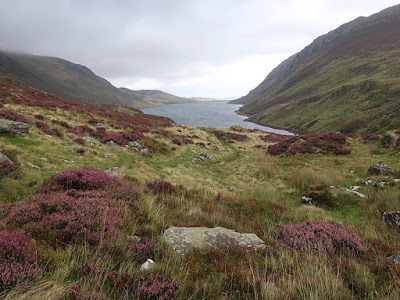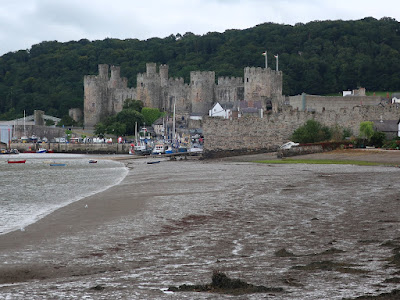Tuesday 27th August 2024
On the twenty-first and final stage of the Cambrian Way I should have been walking from Llyn Ogwen to Conwy Castle over the Carneddau Mountains, however, just as on many days in the second half of the trail, the weather was bad with strong winds and rain, so I wasn’t going to be following the mountain top route. I had considered following the Snowdonia Way starting from Bethesda, but the distance was thirty-five kilometres and would take me ten and a half hours, which was not possible when I needed to get a bus to Bethesda first and then catch a train home when I reached Conwy. My next thought was, what is the most direct route from where I was in the Nant y Benglog valley, east of Llyn Ogwen, to Conwy? So I plotted a course on my map through the mountains and along the eastern slopes above the valley of Dyffryn Conwy to finally reach the town of Conwy, which would take me six or seven hours and give me plenty of time to catch my train. After overnight rain I was surprised to wake up to dry weather and a dry tent when I put it away for the last time on this holiday. From the campsite where I had been staying I set off across the A5 road and onto a bridleway that climbs the hillside, passing the rental property of Tal Y Braich and after crossing a stream became a very boggy and indistinct path. This soon bore no resemblance to the route of the bridleway on my map and brought me to a leat, a water channel that diverts streams into a reservoir, and provided me with a good surface to walk alongside it. Eventually I reached a point overlooking Llyn Cowlyd Reservoir where strong winds pushed me along just as it started to rain.
Once I had managed to put my waterproofs on I followed the bridleway down to the side of the reservoir, which was much more sheltered from the winds, and eventually led me to the dam. The access road now provided me with a broad track to follow and led me into the valley of the Afon Ddu which was marred by a large pipeline that traverses the landscape from the reservoir. After a while I realised that I should have come off the access road and taken a path that the Ordnance Survey characterises as ‘other routes with public access’ and is marked by green dots. To get onto this I had to walk up to the pipeline and squeeze underneath it before I could reach the path that I should have been on, and which aerial views don’t show until the point where I joined it. My route brought me past a herd of cows, over the blustery hill and down a stony path into the valley of the Afon Porth-llŵyd where I found a road which would largely take me all the way into Conwy, though I still had a long way to go. Judging by the strong winds blowing through the valley I felt I was right to come this way and not brave them from the tops of the mountains. When the weather is this bad I don’t mind walking along a road as it’s the best way of getting through tedious scenery.
After climbing out of the valley and then down into the valley of the Afon Dulyn I came off the road for a brief spell to pass through woodland, across the stream and along an enclosed path. From the road at the far end I now stayed on narrow country lanes that followed the edge of the Eryri National Park for many tedious hours. At one point I thought I must be nearing Conwy so I checked my map and discovered that I had another hour and a half of walking to go which was soul-destroying, but I kept on through the improving weather until eventually I came into Conwy and picked up the route of the Cambrian Way. Even though I hadn’t followed the trail over the Carneddau Mountains, I was still going to complete the Cambrian Way which I had started many weeks earlier. I passed through the old walls and into the narrow streets of the medieval town, turning left into High Street and then right into Castle Street before finally reaching a roundabout beside the Guildhall with the imposing walls of the thirteenth century Conwy Castle ahead of me. One and a half months earlier I had stood before the gates of Cardiff Castle with the noise of a demonstration behind me and now I was before Conwy Castle with many tourists crowding the streets. Even though I had come off the Cambrian Way on the northern slopes of Plynlimon to take a bad weather course around the mountains I still managed to cross Wales from Cardiff to Conwy and I could be satisfied at reaching my goal.
The bad weather that had plagued me over the last nine days on the trail was just one thing that didn’t go well as I also suffered from fatigue that could have also prevented me from taking the mountain route through Eryri/Snowdonia. I don’t think I was mistaken in my belief that I could do the Cambrian Way and with the lessons learnt it is very tempting to try again. I reached Conwy by two-thirty and with my train not due for another two hours I had some time to wander around the town and begin the long recovery process from my strenuous walk along the Cambrian Way.











